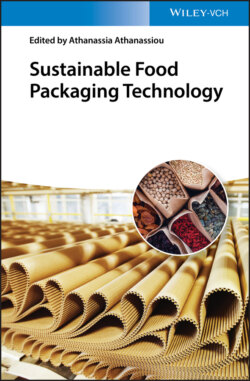Читать книгу Sustainable Food Packaging Technology - Группа авторов - Страница 21
1.3.6 Bio‐based Polyethylene Terephthalate
ОглавлениеPET is a copolymer of monoethylene glycol (MEG) and terephthalic acid, and one of the most studied polymers to be transformed in commercial bio‐based plastics, which can be derived from plant‐based sugars and agricultural residues. This interest gave life to a technological collaboration between several companies, such as Coca‐Cola (Atlanta, USA), Ford (Detroit, USA), Heinz (Sharpsburg, USA), Nike (Eugene, USA), Danone and Procter & Gamble (Cincinnati, USA), Avantium (Geleen, the Netherlands), and Micromidas (San Jose, CA), to develop commercial processes for the production of bio‐PET. The source of petrochemical terephthalic acid is primarily from the oxidation of p‐xylene, obtained from the catalytic reforming of naphtha. More than 98% of the p‐xylene produced globally is converted to terephthalic acid and the global demand for purified terephthalic acid is expected to exceed 60 million tons by 2020, being most of it used for PET production. As a result of this cost‐competitive demand, bio‐based terephthalic acid made at equal purity and cost as the petroleum derived terephthalic acid would have a clear market advantage as well as a lower price volatility due to the non‐dependence on petrochemical p‐xylene [77]. However, bio‐PET is currently produced from plant‐based monoethylene glycol (bio‐MEG) whereas terephthalic acid is still derived from petroleum. Toyota Tsusho (Nagoya, Japan) and China Manmade Fibers Corporation (Taipei, China) jointly founded a company in November 2010 that manufactures bio‐MEG made from plant derived bioethanol [78]. Other companies such as SCG Chemicals (Bangkok, Thailand) also produce bio‐MEG from residues of agricultural activities including molasses, hay, and bagasse [79]. The first partially bio‐PET product was commercialized by The Coca‐Cola Company (Atlanta, USA) under the trade name of PlantBottle™, where a 30 wt% of bio‐MEG was used for the production of bio‐PET (Company). At the moment, some researchers are working on the synthesis of bio‐based terephthalic acid to obtain fully bio‐PET. This process is based on an integrated method to convert forest residues to isobutanol [80], which can be processed into p‐xylene [81], the precursor of terephthalic acid. Although the 100% bio‐based bottle was released in Milan in June 2015, the so‐called PlantBottle™, shown in Figure 1.5, has not reached yet the price parity to equal the price of producing current Coca‐Cola PET bottles [82]. PepsiCo (New York, USA) also announced the use of a PET bottle made entirely with renewable resources coming from waste carbohydrate biomass obtained from the food industry such as orange peels, oat hulls, corn husks, and potato scraps [83].
Similar to bio‐PE, bio‐PET is not biodegradable but it has the same properties as conventional PET made from natural gas or oil feedstocks. Current partially bio‐PET is used to make a number of products including drinking water and soda bottles, making them environmentally friendly and a new packaging alternative. Products made from bio‐PET have the same qualities as regular PET in its distinctive functions, weight, appearance, and it can also be recycled and reused [79]. This material can be recycled, incinerated, or landfilled, but it can also be intended for disposal by composting, where it undergoes soil degradation to CO2 and water [9]. Enzymatic hydrolysis of aromatic/aliphatic polyesters was first demonstrated in the 1990s for PET with several esterases, lipases, and especially cutinases [84, 85]. Nevertheless, PET hydrolysis by enzymes is a relatively slow process, since the biocatalysts are specialized to attack natural polyesters such as cutin and were not designed by nature for degrading manmade synthetic polyesters in the first instance [85].
Figure 1.5 Image of the PlantBottle™ made up to 30% from biomass and 100% recyclable.
Source: Courtesy of the Coca-Cola Company (Atlanta, USA).
